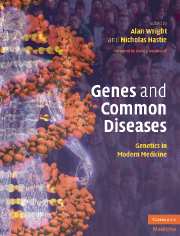Book contents
- Frontmatter
- Contents
- List of Contributors
- Foreword
- Section 1 Introductory Principles
- Section 2 Common Medical Disorders
- 13 Developmental disorders
- 14 Genes, environment and cancer
- 15 The polygenic basis of breast cancer
- 16 TP53: A master gene in normal and tumor suppression
- 17 Genetics of colorectal cancer
- 18 Genetics of autoimmune disease
- 19 Susceptibility to infectious diseases
- 20 Inflammatory bowel diseases
- 21 Genetic anemias
- 22 Genetics of chronic disease: obesity
- 23 Type 2 diabetes mellitus
- 24 Genetics of coronary heart disease
- 25 Genetics of hypertension
- 26 Obstructive pulmonary disease
- 27 Skeletal disorders
- 28 The genetics of common skin diseases
- 29 Molecular genetics of Alzheimer's disease and other adult-onset dementias
- 30 Major psychiatric disorders in adult life
- 31 Speech and language disorders
- 32 Common forms of visual handicap
- 33 Genetic and environmental influences on hearing impairment
- 34 Pharmacogenomics: clinical applications
- Index
- References
27 - Skeletal disorders
Published online by Cambridge University Press: 17 August 2009
- Frontmatter
- Contents
- List of Contributors
- Foreword
- Section 1 Introductory Principles
- Section 2 Common Medical Disorders
- 13 Developmental disorders
- 14 Genes, environment and cancer
- 15 The polygenic basis of breast cancer
- 16 TP53: A master gene in normal and tumor suppression
- 17 Genetics of colorectal cancer
- 18 Genetics of autoimmune disease
- 19 Susceptibility to infectious diseases
- 20 Inflammatory bowel diseases
- 21 Genetic anemias
- 22 Genetics of chronic disease: obesity
- 23 Type 2 diabetes mellitus
- 24 Genetics of coronary heart disease
- 25 Genetics of hypertension
- 26 Obstructive pulmonary disease
- 27 Skeletal disorders
- 28 The genetics of common skin diseases
- 29 Molecular genetics of Alzheimer's disease and other adult-onset dementias
- 30 Major psychiatric disorders in adult life
- 31 Speech and language disorders
- 32 Common forms of visual handicap
- 33 Genetic and environmental influences on hearing impairment
- 34 Pharmacogenomics: clinical applications
- Index
- References
Summary
Introduction
Recent years have witnessed major advances in our understanding of the genetic basis for many skeletal disorders. In several instances, particularly with the less common Mendelian diseases, the responsible gene has been mapped, mutations identified, and their functional significance determined, contributing significantly to our understanding of the molecular basis for pathogenesis. For more common disorders where susceptibility is complex, a complete picture of the responsible genetic polymorphisms and how they influence pathogenesis has been more difficult to achieve. In this chapter we focus on our current understanding of the genetic basis and pathogenic mechanisms for disorders of bone homeostasis. For readers interested in the genetic basis of developmental disorders of the skeleton, we recommend a recent review (Kornak and Mundlos, 2003).
Bone resorption and bone formation are ongoing processes in both the developing and mature skeleton. Even during growth, where the balance favors bone formation, bone resorption is necessary to remove calcified cartilage prior to the formation of mature bone. In the adult skeleton, there continues to be a dynamic balance between these processes that serves both metabolic and mechanical needs of the individual. Although bone mass continues to increase during childhood, it peaks between the ages of 25 and 35 years, and then begins a steady decline that becomes most prominent after age 50 years when bone formation does not fully compensate bone loss. The delicate balance between bone formation and bone resorption is maintained largely by the coordinated actions of two cell types, osteoblasts and osteoclasts.
- Type
- Chapter
- Information
- Genes and Common DiseasesGenetics in Modern Medicine, pp. 406 - 426Publisher: Cambridge University PressPrint publication year: 2007
References
- 1
- Cited by



